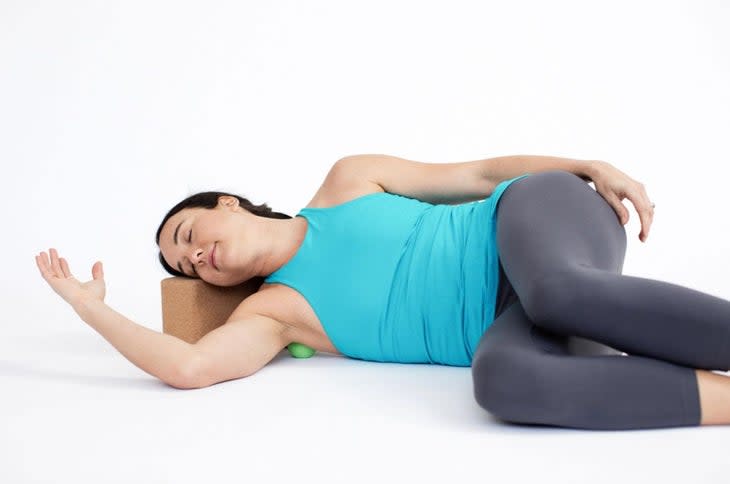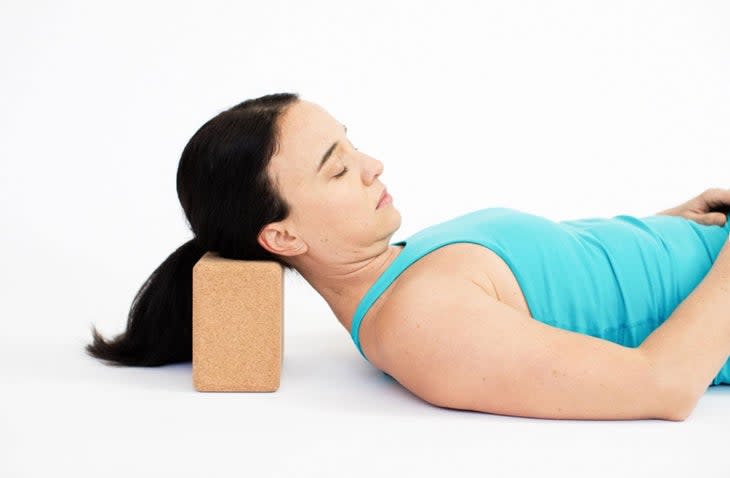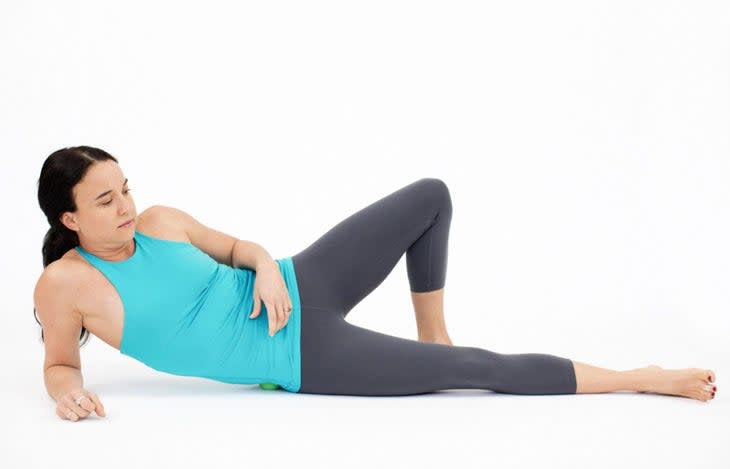What is Myofascial Release?
This article originally appeared on Yoga Journal
If you're like me, one of the primary reasons you practice yoga is to reconnect the different aspects of yourself--physically, mentally, emotionally, and spiritually. That means practicing postures in a way that emphasizes how the pose feels rather than whether you're doing it "right." In recent years, one of the most potent and accessible complements to my yoga practice--one that helps me practice yoga in a way that feels better physically and that allows me to create a deeper connection to my body and myself--has been myofascial release.
What exactly is fascia?
In both the yoga and sports medicine realms, we have long overemphasized flashy, movement-producing muscles. Yet a recent research review suggests that most soft tissue injuries are not happening in the muscle tissue but rather in the connective tissue surrounding them.
The connective tissues comprise tendons, ligaments, and fascia. Quite simply, these tissues connect everything in our bodies. Fascia, in particular, encases every part of the body--muscles, bones, blood vessels, organs, and nerves. One of the main functions of fascia is to allow us to function as a more powerful, unified whole. This tissue also has many other functions, including the storage of elastic energy that allows us to move more efficiently with less energy expenditure. This makes the health of the connective tissue essential for injury prevention and tissue resilience.
What is myofascial release?
With more than 250 million nerve endings, the fascia is considered our largest sensory organ. Studies show it contains an abundance of nociceptors, proprioceptors, and interoceptors that influence our experience of pain, movement, and, ultimately, the world. This tissue is also chock full of mechanoreceptors, a type of sensory nerve that responds to mechanical pressure--such as bodywork and myofascial release--that can have a potent therapeutic effect.
Additionally, the connective tissue is thixotropic, which means it becomes more solid or gel-like when sedentary and more fluid when agitated or mobilized, suggesting that tools such as balls or foam rollers can be an effective way to mobilize and rejuvenate tissues.
Another thing to keep in mind is that the components of the fascia--cells, fibers, and ground substance--are constantly turning over to maintain a resilient matrix. However, with age, this turnover process naturally slows down and the stiffness of these tissues increases, making myofascial release in particular a helpful tool to help counteract these age-related changes.
Types of myofascial release
Myofascial release can be an accessible and effective way to help with range of motion, injuries, scar tissue, tension, tissue recovery, and muscle function. It is also a way to reconnect to areas of the body where we feel disconnected from physically or emotionally. It can also regulate pain and optimize connective tissue health to minimize injuries for athletes.
There are several ways to support the health and resilience of fascia. Particularly effective strategies in the yoga setting include vinyasa yoga, Yin yoga, and myofascial release.
Movement-oriented practices like vinyasa yoga can be a valuable tool to mobilize the fascia and help maintain important gliding between the tissues. The long-held stretches of Yin yoga are a strong way to target large areas of fascia and preliminary research suggests Yin yoga can also have anti-inflammatory effects. Myofascial release (MFR) involves tools, such as tennis balls or foam rollers, to roll or relax tender or restricted areas. MFR an be an effective strategy for regulating pain, reducing tissue stiffness, and supporting autonomic nervous system regulation (aka the relaxation response), all of which help support the youthfulness of these tissues.
3 essential tips for practicing myofascial release (MFR) at home
After many years of studying fascia, teaching others about it, and working with thousands of patients, my experience supports what science has proven: the state of our connective tissues can have an incredible influence on our pain, movement, and quality of life.
So how can we better support this precious tissue to maintain its resilience, minimize injuries, and feel our best? There are three common misconceptions about myofascial release that I see come up again and again for people. There are some suggestions that I share with patients and students while leaving space for the importance of supporting this tissue through what we do best in our yoga practice--moving, breathing, feeling, and listening.
1. Less is more when you experience pain
Contrary to popular belief, more intensity is not necessarily better when you practice MFR. With the dense innervation of the connective tissues, it's important to ease into these techniques so your nervous system can communicate that relaxation. It's actually counterproductive to induce pain by pushing on tissues too aggressively.
You don't need to work directly into painful tissues. Instead, search for areas nearby or in other parts of the body that bring relief. Because the connective tissues are interconnected from head to toe, what feels helpful in one area may be the missing link you've been searching for in a seemingly separate or distant area. Search for helpful areas that are tender but allow you to relax and perhaps feel some relief. Our goal is to help enhance circulation to keep these tissues healthy and durable. So, get curious! Look for areas you can work with and ease into it.
2. Myofascial release doesn't need to take a lot of time
Around 60 seconds in each position is usually plenty. If you find a place you want to linger in, great. But if you find yourself holding your breath and tensing up, it's probably time to move on. Inducing pain here is not a helpful strategy. If you find a helpful spot, try adding it into your regular routine. If you find a spot that feels painful, find another nearby spot or skip that point and move on.
3. Practice myofascial release anytime
You can use MFR before or after your yoga practice, whether to prepare or rejuvenate the tissues. Experiment. Each of us is unique in what we need. When you approach the practice with the mindfulness of yoga, you can explore and find what's most beneficial for you.
Myofascial release at home
I have found no greater feedback than from the MFR work I have done with patients and students over the decades. I find that the best research is the research that works for you, so below are three experiments you can try out for the shoulders, hips, and neck. See how MFR can help you feel your best.

Myofascial release for your posterior shoulder
Why it helps: The posterior rotator shoulder is a potent area I find to be very helpful, especially for those who practice vinyasa yoga. Many of us never think to pay attention to this area until we have a problem, but this area works hard to support us anytime we are bearing weight on our hands.
How to: Begin on your back with a tennis ball or MFR ball in your left hand and a pillow or block under your head. Take your left arm under your right armpit and place the ball just behind your right shoulder blade. From there you can either stay on your back or start to roll toward your right side. The more you roll toward your right side, the more intense the sensation will be. If you prefer less intensity, lean more toward your back or left side.
If you're not feeling much, try making a few circles with your shoulder blade there until you find a tender spot that you can relax into. If it's not too tender, you can also explore bending your elbow and making a windshield wiper movement there with your elbow on the floor. Find one of these variations you can relax into and stay there for about a minute before you repeat on your left side.

Myofascial release for your neck
Why it helps: As we clock more hours at our screens--especially phones and laptops which require us to look down--our neck and shoulders start to cry out for attention. This technique is one that clients love and that I repeat often on myself to rejuvenate my neck and shoulders.
How to: To begin, start on your back and place a block or foam roller underneath the base of your skull. Begin by relaxing your neck and letting your head rest heavy on the block. Then slowly rock your head to the right and back to center a few times to find a tender spot. Relax there for a minute or two, using your exhales to help you soften and release. Then repeat on your left side.

Myofascial release for your outer hip
Why it helps: Another area needy for some love and attention, the gluteus medius is our most powerful hip stabilizer and a key player for hip, back, and sacroiliac (SI) joint issues so the connective tissue around it is also hungry for some TLC.
How to: To begin, come onto your right side. Place a tennis ball underneath your outer hip, just behind the boney prominence on the front of your hip (the ASIS). You can lie flat on your side or prop yourself up on your forearm. If you're relatively comfortable there, try rolling the ball on the meaty tissues of the outer hip there until you find a tender spot you can relax into. Feel free to explore the entire side of the hip here (although avoid anything that feels boney). Once you find a tender but tolerable spot, stay here and breathe as you do your best to relax into it. If you're having trouble relaxing or the discomfort feels too intense, you can also place a second ball right next to the first one there to disperse the pressure. Stay for 2-3 minutes if you find a good spot or you can select 2 or 3 spots in this area and stay for about 1 minute in each. Repeat on your second side.
Video loading...
Happy rolling!
If you're interested in additional information on using MFR in a yoga or therapeutic setting, check out the online Yoga Medicine(r) MFR Teacher Training for yoga teachers, healthcare professionals, movement specialists, or those with a deep interest in MFR.
About our contributor
Tiffany Cruikshank, L.Ac., MAOM, is the founder of Yoga Medicine(r), a community of yoga teachers focused on fusing contemporary science and research with traditional yoga practices to help people thrive and live their best lives. Tiffany's teaching taps into her medical background in acupuncture, Chinese medicine, sports medicine and orthopedics and is guided by a strong anatomic focus as well as her ability to convey a clear understanding of complex subjects. Tiffany's passion is training teachers to understand the inner workings of the body to individualize therapeutic yoga practices. She has trained more than 15,000 teachers around the world since 2002.
Tiffany is also the founder of the Yoga Medicine Seva Foundation, a nonprofit that works to fight human trafficking and sexual exploitation in India through education and entrepreneurship. She has also written two books, runs the Yoga Medicine(r) podcast, and posts new practices weekly on YogaMedicine(r) Online.
For exclusive access to all of our fitness, gear, adventure, and travel stories, plus discounts on trips, events, and gear, sign up for Outside+ today.

